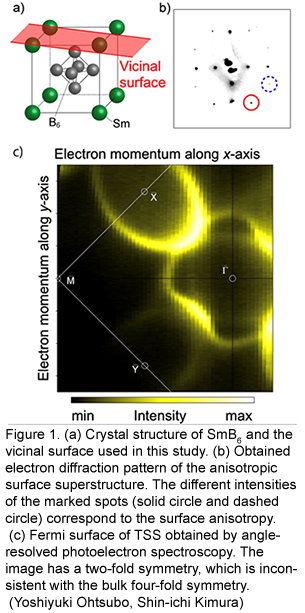English version 3 October, 2022 on EurekAlert!
Researchers have found the topological surface electronic structure of samarium hexaboride can be controlled by changing the surface condition. Their findings could lead to new technologies for higher speed of upcoming electronics.
-------------------------------------------------------------------

Topologically protected forms, such as a Möbius strip, are unable to be changed without breaking them via methods such as cutting. Researchers from Osaka University, Institute for Molecular Science and two other institutes have developed a new means of changing surface electronic structures, detouring its topological protection.
Physicists have believed that metallic surface states of topological insulators are very stable because the surface states are protected by the wave function symmetry of the bulk electronic structure. This property is an important advantage for applied products used in various surrounding environments; however, this feature also means that it is difficult to control the surface state according to one's purpose.
"This was thought to be advantageous, such as for preventing contamination effects," says lead author Yoshiyuki Ohtsubo, "but we have found that the topologically protected surface states can be controlled by the modification of the surface symmetry without touching its inside, which will be a new control method for topological electronic states useful for quantum computing and other advanced technologies."
A ground-breaking result of this research is that the electronic structure of a slightly tilted surface from the bulk plane of symmetry of single-crystalline samarium hexaboride (SmB6) is not the same symmetry as the bulk. This result indicates that a different topological surface state (TSS) has been created by fabricating this new surface atomic structure.
"In other words, the surface electronic structure and the conducting property can be controlled through fabrication methods," explains Shin-Ichi Kimura, senior author. "This will serve as a method to control topologically protected electronic structures and their physical properties."
This research result has revealed that the topological surface electronic state, which was thought to be "strictly" determined by bulk symmetry, has many degrees of freedom and can be "flexibly" controlled by manipulating the surface atomic structure. This achievement is expected to be applied to next-generation devices with low power consumption and high speed using the same electronic state, as well as to information transfer in quantum computers.
Information of the paper
Journal: Nature Communications
Title: Breakdown of bulk-projected isotropy in surface electronic states of topological Kondo insulator SmB6(001)
Authors: Yoshiyuki Ohtsubo, Toru Nakaya, Takuto Nakamura, Patrick Le Fèvre, François Bertran, Fumitoshi Iga, and Shin-Ichi Kimura
DOI: 10.1038/s41467-022-33347-0
Contact Person
Shin-Ichi Kimura
Osaka University / Institute for Molecular Science
E-mail: kimura.shin-ichi.fbs_at_osaka-u.ac.jp
*Please replace the "_at_" with @
1152

